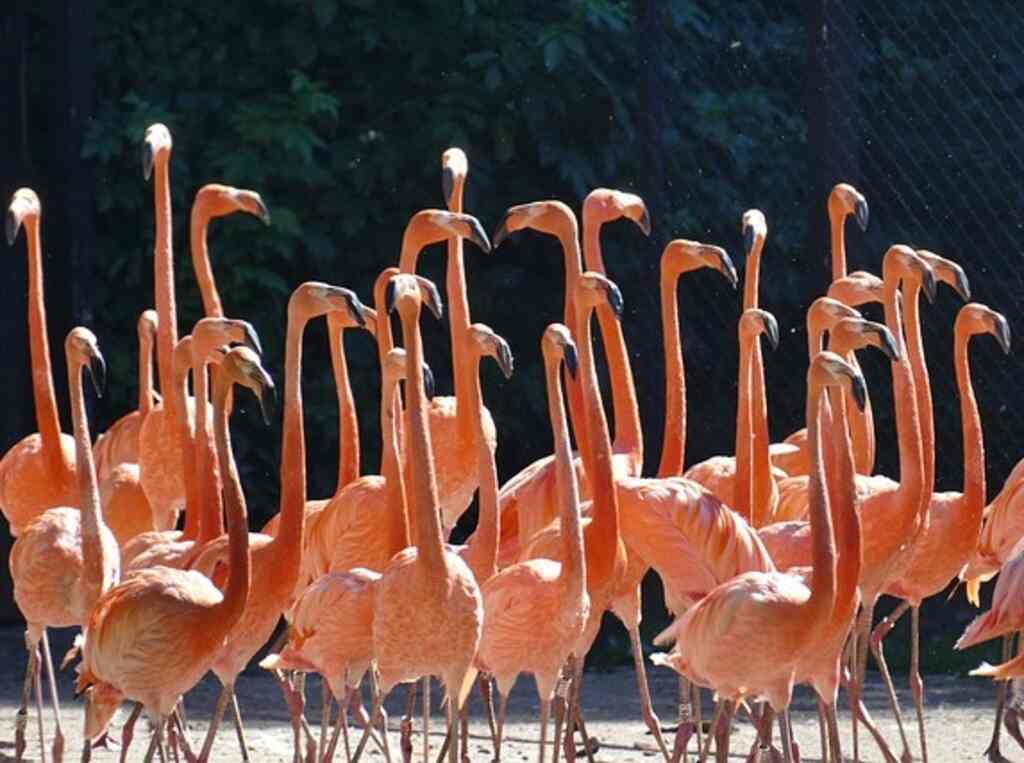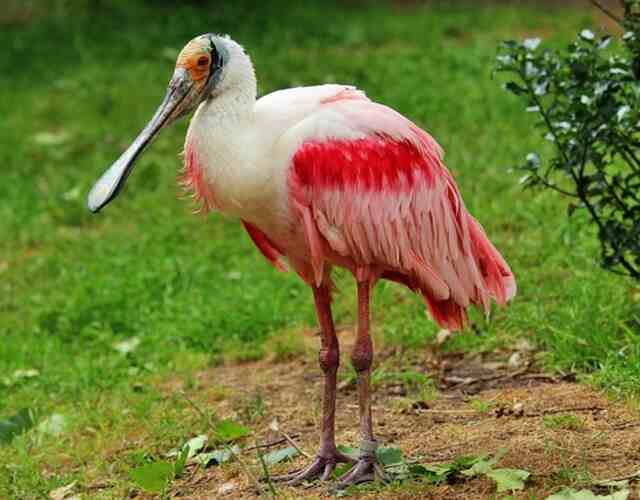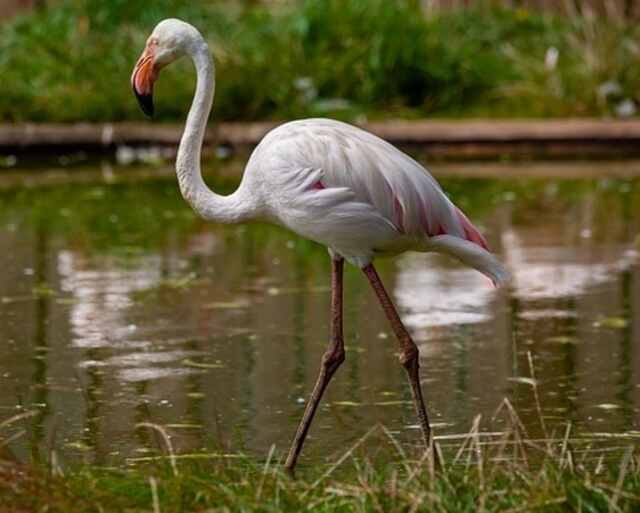Get ready to have your mind blown, flamingo lovers! Did you know that there are not one, not two, but eleven different birds that look like flamingos? That’s right, these pink beauties have some serious look-alikes.
From the eye-catching Roseate Spoonbill to the majestic American White Pelican, these birds share some striking similarities with flamingos but also possess unique features that set them apart. Get ready to discover the fascinating world of flamingo doppelgangers!
Table of Contents [show]
American Flamingo (Overview)
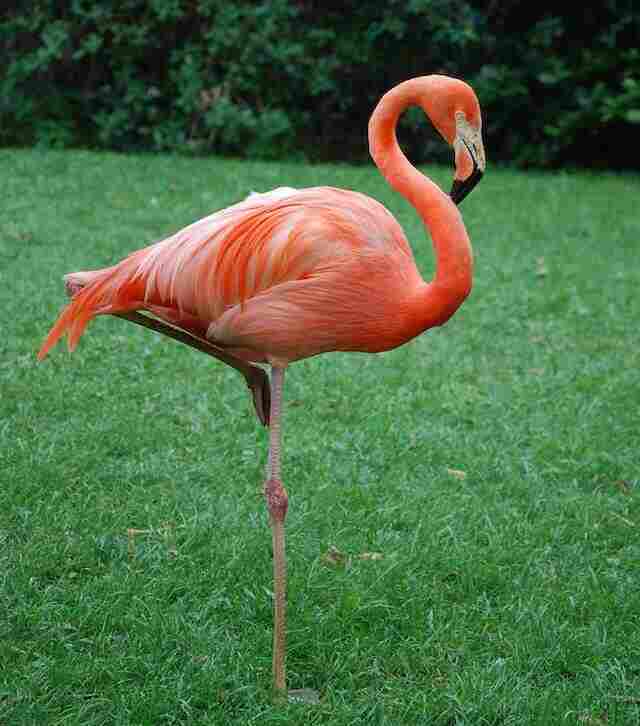
Characteristics
Behold the remarkable American Flamingo, Phoenicopterus ruber, a magnificent bird with a unique and stunning pink plumage, elongated legs, and a distinctively curved beak. These incredible creatures can grow up to towering heights of 4-5 feet and weigh between 4-8 pounds, making them one of the most awe-inspiring bird species in the world.
And what’s more, their pink feathers are a result of their diet, which is rich in carotenoids – pigments found in crustaceans and algae that give them their vibrant pink hue.
Distribution Range
The American Flamingo is an exquisite bird species that can be found in several breathtaking regions, such as the tropical Caribbean, the volcanic Galápagos Islands, and the lush northern coast of South America. These fascinating birds also frequently visit parts of Florida and the Yucatan Peninsula, adding a touch of color and wonder to these already stunning areas.
Habitat
American Flamingos are commonly found in coastal lagoons, salt flats, and mangrove swamps. They prefer shallow, saline water that provides a good source of food and nesting sites.
Diet
The American Flamingo’s diet consists of algae, crustaceans, and small fish. They use their specialized beaks to filter out small organisms from the water.
Similarities and Differences with Other Flamingos
Similarities: Like other species of flamingos, the American Flamingo is a filter feeder and uses its beak to extract small organisms from the water. They also have similar social behaviors, gathering in large flocks for breeding and feeding.
Differences: The American Flamingo stands out amongst other species with its grandiose size and vivid coloration that radiates an unparalleled vibrancy. Although their range may be more restricted compared to some other species, their striking presence more than makes up for it.
The American Flamingo’s distinguishing feature is its extraordinary, downward-curved beak, which sets it apart from its flamingo counterparts and adds to its individuality.
Birds That Look Like Flamingos
Roseate Spoonbill
The Roseate Spoonbill is a striking bird with a long spoon-shaped bill, bright pink plumage, and striking red eyes. They are found in wetlands and marshes across the southeastern United States, Central and South America. Their diet consists of fish, insects, and crustaceans, which they catch by sweeping their bill back and forth through the water.
They are known for their distinctive mating dance which involves the males bringing sticks and other nesting material to the female.Flamingos and Roseate Spoonbills share many similarities in terms of their appearance and habitat. Both birds are wading birds with long legs and necks, and they are both found in wetlands and marshes.
However, while Roseate Spoonbills have a bright pink plumage and a spoon-shaped bill, Flamingos have a pink and white plumage with a distinctive downward-curved beak used for filter feeding.
Flamingos are typically larger than Roseate Spoonbills, and they are found in a wider range of habitats including salt pans and alkaline lakes. Both birds are social and form large flocks, and they both feed on small organisms such as algae, crustaceans, and insects.
Scarlet Ibis
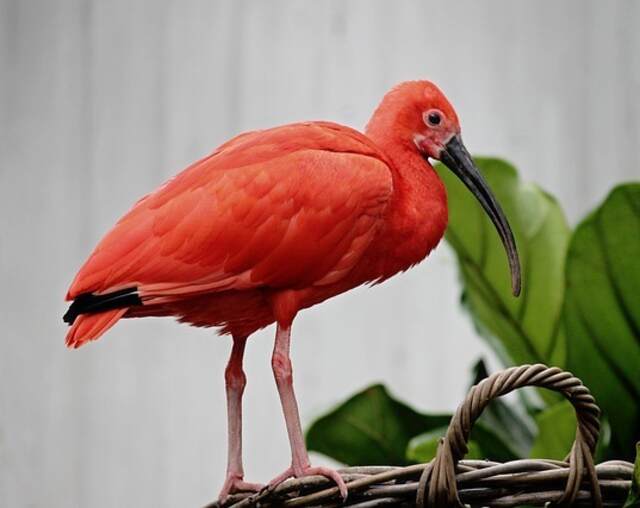
The Scarlet Ibis is a breathtakingly beautiful bird, with vivid red plumage that sharply contrasts with its lengthy, slender black bill and legs. It occupies a territory that spans from the northeastern region of South America to the southern portion of the United States, where it can be spotted in swampy areas, marshes, and other wetlands.
The ibis mostly feeds on crustaceans like shrimp and crabs, but it also consumes small fish, insects, and other invertebrates. Its breeding habits are engrossing, with both male and female ibises working cooperatively to build nests and nurture their offspring.
Despite sharing some similarities, the Scarlet Ibis and Flamingos differ greatly in various aspects. Flamingos, with their elongated, spindly legs and pink or reddish plumage, are larger than Scarlet Ibis and have a more distinct appearance.
They reside in a wider variety of habitats, such as salt flats, lagoons, and shallow lakes, and their diet comprises small crustaceans, algae, and other tiny organisms that they filter out of the water using their specialized beaks. Unlike Scarlet Ibis, flamingos are gregarious birds that often congregate in sizable flocks.
American White Pelican

The American White Pelican is a grandiose waterbird, adorned with snow-white plumage, an enormous wingspan of up to nine feet, and a vibrant, orange bill. These pelicans are distributed throughout North America, from the Pacific to the Gulf of Mexico and the Great Lakes, and have a preference for shallow wetlands, lakes, and coastal regions, where they hunt for fish, crustaceans, and amphibians.
Equipped with their colossal wings, these birds are skillful divers and excel at catching prey underwater. In contrast, Flamingos are an alluring, pink bird species, distinguishable by their thin legs and curvy, downwards-facing bills.
Although both species can be found in wetland habitats, Flamingos typically inhabit warmer, tropical regions, such as parts of South America, Africa, and the Caribbean. Their diet mainly consists of shrimp, algae, and other minute aquatic invertebrates.
Flamingos are much taller than Pelicans and are known for their sociable nature, often congregating in large flocks to feed, mate, and migrate together. Despite their differences, both species are excellent examples of the intriguing and varied birdlife that can be found in wetlands worldwide.
Glossy Ibis
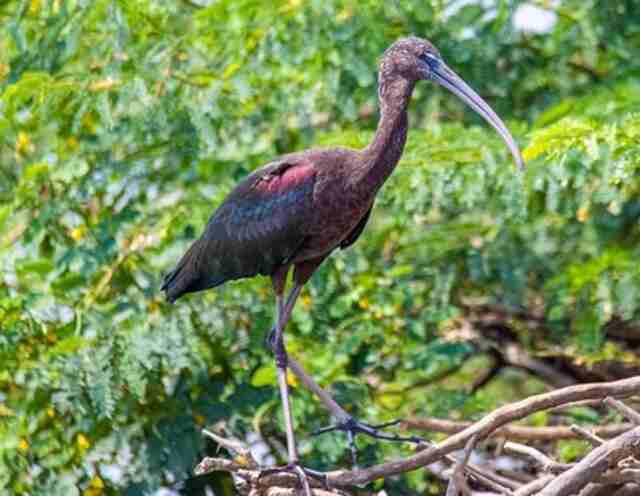
The Glossy Ibis is a striking wading bird that boasts glossy, iridescent feathers that appear to change color depending on the light. They are slender birds with long, curved bills and are found in wetlands, marshes, and swamps throughout Africa, Europe, Asia, and the Americas.
They feed on small aquatic animals like fish, frogs, and insects, and occasionally, they may also consume small reptiles and mammals.In contrast, the Flamingo is a large, iconic wading bird known for its vibrant pink feathers and distinctively curved beak.
They are found in parts of Africa, South America, and the Caribbean, where they inhabit shallow lagoons and salt pans. Flamingos feed on tiny organisms such as algae and shrimp, which they filter from the water using their uniquely adapted beaks.
They are larger and more brightly colored than the Glossy Ibis and are known for their flamboyant courtship displays and social behavior, which includes standing on one leg in a group.
African Spoonbill

The African Spoonbill, also known as Platalea alba, is a large wading bird found in sub-Saharan Africa. Its most distinctive feature is its spoon-shaped bill, which it uses to filter food from mud and shallow water. These birds can grow up to 32 inches tall and have a wingspan of up to 48 inches.
Their preferred habitats include wetlands, swamps, and shallow lakes. Their diet consists mainly of fish, insects, and crustaceans. While the African Spoonbill and Flamingos share a few similarities, they have many differences. Flamingos are more colorful than Spoonbills, with their vibrant pink and red plumage.
Flamingos are also larger in size, with some species growing up to five feet tall. Flamingos primarily feed on algae and shrimp, while Spoonbills have a more varied diet, including fish, insects, and crustaceans.
Both species prefer to live near wetlands and other bodies of water, but Flamingos are more commonly found in saltwater habitats. Additionally, Spoonbills are solitary birds, while Flamingos are known to live in large flocks.
Eurasian Spoonbill
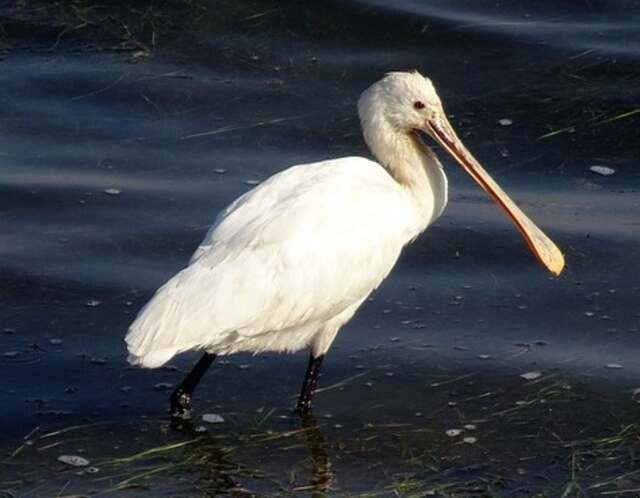
The Eurasian Spoonbill, a large wading bird, has distinct characteristics such as its long spoon-shaped bill, white plumage, and black legs. It measures about 80-90 cm in length and has a wingspan of 120-135 cm. Found in wetlands, marshes, and shallow waters across Europe, Asia, and Africa, this bird feeds on small fish, insects, and crustaceans.
The species is known for its unique feeding behavior, where it swings its bill from side to side, stirring up prey in the water before catching it. The Eurasian Spoonbill and Flamingos, though sharing some similarities, are quite distinct birds. Flamingos, with their leggy, curvaceous bodies, are much larger and sport a stunning pink hue that makes onlookers gawk.
In contrast, Spoonbills can be found strutting their stuff across parts of Europe, Asia, and Africa. Both birds share a love for similar food and habitats, but Flamingos have made themselves at home in Africa, Southern Europe, and South America, while Spoonbills are dispersed throughout Europe, Asia, and Africa.
White-faced Ibis
The White-faced Ibis (Plegadis chihi) is a bird species with distinctive features. Its body is mostly dark with iridescent green and maroon highlights. They have a white feathered face, red eyes, and a long, curved bill. They are widespread in the Americas, breeding from western Canada to central Mexico and migrating south to South America. White-faced Ibis prefers freshwater marshes, ponds, and wetlands.
Their diet mainly consists of insects, aquatic invertebrates, and small fish. Who would’ve thought the White-faced Ibis and Flamingo had anything in common? These wading birds share similarities and differences that are worth noting. Both have long, slender legs and curved beaks, but the Flamingo towers over the Ibis at 1.2 to 1.4 meters compared to 0.6 to 0.8 meters.
While Flamingos boast a bold pink hue, the Ibis has a more subdued, dark appearance. Flamingos can be found in Africa, Asia, America, and Europe, while the Ibis only inhabits the Americas. And let’s not forget about their diets – Flamingos indulge in algae and crustaceans, while the Ibis dines on insects, aquatic invertebrates, and small fish.
Limpkin
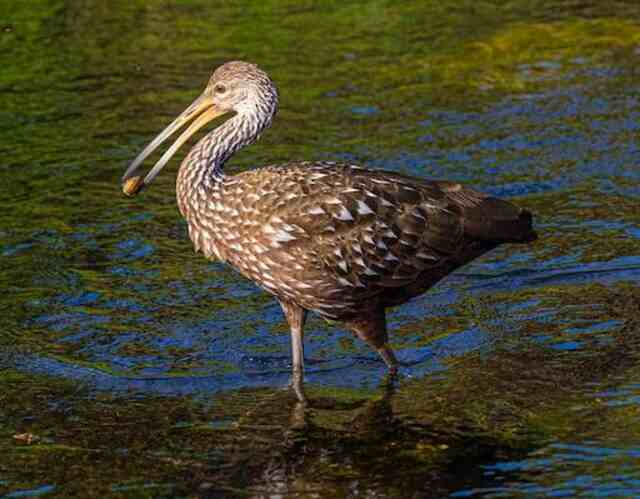
The Limpkin (Aramus guarauna) is a unique bird species found in wetlands of North and South America. They have a distinctive long and curved bill, gray-brown feathers, and a wingspan of up to 4 feet. Limpkins are predominantly carnivorous, feeding on apple snails, insects, and small aquatic animals.
They also produce a loud, distinctive wailing sound that echoes through the wetlands. These birds are monogamous and territorial, nesting on the ground in dense vegetation. While Flamingos and Limpkins share some similarities, they have many differences.
Flamingos (Phoenicopteridae) are known for their striking pink coloration, while Limpkins have a more subdued coloration. Flamingos have a filter-feeding diet of brine shrimp and blue-green algae, while Limpkins are primarily carnivorous. Flamingos live in large groups in coastal regions, while Limpkins prefer freshwater wetlands.
Flamingos are much larger than Limpkins, with a wingspan of up to 5 feet. Both species are social, but Flamingos are known for their synchronized group movements during feeding and courtship displays, while Limpkins are solitary and territorial.
Reddish Egret

The Reddish Egret, also known as Egretta rufescens, is a big, lanky wading bird with a unique shaggy look, thanks to its long, tousled feathers. These incredible birds can be spotted along the coastlines of North, Central, and South America, and they prefer to live in tidal flats, saltwater lagoons, and marshes.
What sets the Reddish Egret apart is its special foraging technique, where it runs, jumps, and flaps its wings to stir up prey, which typically includes small fish, crustaceans, and other aquatic creatures. Now, let’s talk about the differences between these amazing birds!
Although both Reddish Egrets and Flamingos are wading birds, they are worlds apart in terms of behavior and appearance. Flamingos are enormous, with lengthy legs and necks, and their standout feature is their striking pink plumage. These magnificent creatures can be found in various habitats, including estuaries, salt pans, and shallow lakes.
Flamingos tend to feed on algae, shrimp, and other tiny aquatic invertebrates by filtering their food from the water with their specialized beaks. Unlike the Reddish Egret, who is active and nimble, Flamingos prefer to stand still in massive flocks, often on one leg.
Graylag Goose
The majestic Graylag Goose (Anser anser) boasts an impressive wingspan of up to 5 feet and can weigh up to 6-7 kg. With a beautiful grayish-brown body, pink bill, and pink legs, this migratory bird can be found across Europe and Asia, spanning from the Arctic Circle to the Mediterranean.
It thrives in open wetlands, marshes, and lakes, feeding on a delectable diet of grasses, herbs, and aquatic plants. The Graylag Goose is renowned for its unmistakable honking call and strong pair bonds, making it a fascinating and beloved species in the birdwatching community.
Flamingos are famous for their pink hue, thanks to their carotenoid-rich diet. They can be found in Africa, the Americas, Asia, and Europe, and prefer shallow, salty lagoons. Flamingos consume crustaceans, algae, and other tiny organisms, and are larger than Graylag Geese, weighing up to 4.5 kg and standing up to 4 feet tall.
One of their unique traits is their unusual feeding method: they filter-feed with their beaks upside down in the water. Social creatures that they are, both birds have distinctive vocalizations and form strong bonds.
Greater Flamingo
The Greater Flamingo, Phoenicopterus roseus, is a large wading bird known for its distinctive pink plumage and long, thin legs. They are found in parts of Africa, southern Europe, and parts of Asia. The species thrives in saline and alkaline lakes, mudflats, and lagoons. Greater Flamingos are filter feeders, using their specialized beaks to extract small organisms like shrimp and algae from the water.
Greater Flamingos are the big shots of the flamingo world. They’re larger and way pinker than other species. They can be found in a wide range of habitats, making them well-traveled birds. Like other flamingos, they use their unique feeding mechanism to filter food particles from the water with their beaks.
But that’s not all that sets them apart. They’ve got differences in size, bill shape, and feather coloration. And let’s not forget their social behavior, which is off the charts! These flashy birds love to gather in large flocks for breeding and feeding.
Conclusion
When it comes to bird species resembling flamingos, similarities can be seen, but differences make them one-of-a-kind. With unique adaptations and specialized feeding methods, these birds have found their niche in various environments.
Whether it’s the American Flamingo in the Caribbean or the Greater Flamingo in Africa, these feathered creatures are nothing short of remarkable, showcasing the stunning beauty and endless diversity of the avian world.
Related Post: 25 Facts About Flamingos That Will Blow Your Mind!

